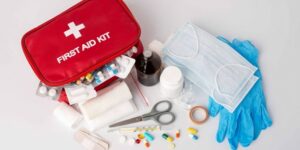12 Oct 2022 What Are Your Business’s First Aid Responsibilities?
Providing adequate first aid to people in the event of sudden illness or injury isn’t simply helpful, it’s a legal requirement. All employers should ensure that an employee who is unwell or hurt at work receives immediate attention that is appropriate to their needs. And the HSE can prosecute in cases where employers have put people at significant risk by not having established first aid protocols.
As an employer, you are responsible for ensuring your employees receive immediate attention if they are ill or injured at work. Depending on the size and type of your business, your responsibilities may extend only to needing a first aid box and a person appointed to take charge of ensuring it is accessible and well stocked.
If you run a larger business or one with bigger risks for illness or injury, you will probably also need a trained first aider.
How do you assess your First Aid responsibilities?
It’s up to you to accurately self-assess your needs and responsibilities based on the criteria set out by the Health and Safety Executive (HSE). To determine whether your business’ first aid provision is adequate and appropriate, the HSE states you should consider the following criteria:
- What is the nature of the work your employees do?
- What are the specific workplace hazards that may result in injury?
- What types of injury are the most likely to occur?
- How big is your workforce?
- What considerations do you need to make for working patterns?
- How many first-aid trained personnel do you need by law?
- How can you ensure continuous provision of first-aid trained personnel? Are you taking into account potential annual leave and sickness absence?
- What health and safety records do you keep and are they sufficient?
- How can you take care of the first aid needs of travelling and remote workers?
- Wherever your staff are located, what is their distance from medical services and how would they access them if required?
- What specific duties do you have towards lone workers, or those working on shared or multi-occupancy sites?
- What are your duties and responsibilities towards members of the public?
What First Aid arrangements does your business need to make?
Your business must appoint someone whose responsibility it is to manage first aid arrangements. This means determining your first aid requirements, communicating them to employees, managing training needs and stocking the first aid kit.
First Aid Training

Once you have a reasonable idea of how many trained first aiders your business needs to provide appropriate cover (and also account for absence and holidays) you’ll need to find and pay for them to complete an appropriate course.
First aid training should result in achieving a certificate in FAW or EFAW, and first aid training should be repeated every three years so staff can requalify. We also recommend annual refresher courses. Although this is not a legal requirement, if first aid skills are not utilised often, knowledge can fade, impairing a first aider’s ability to react appropriately in emergency situations.
Ensure you have a well-stocked first aid kit
What is required for your first aid kit will depend on the results of your risk assessment. For most low-risk working environments, a basic first aid kit checklist will probably look like this:
- Individually wrapped sterile plasters of various sizes
- Sterile eye pads
- Individually wrapped sterile triangular bandages
- Disposable gloves
- Individually wrapped sterile wound dressings of various sizes
- Written information about basic first aid
In more high-risk working environments, you may need to include the following:
- Foil blankets
- Tourniquets
- Adhesive micropore tape
- Clothing shears
- Sterile disposable tweezers
- Disposable aprons

No medication should ever be kept in a first aid kit or administered to people in need of medical treatment. This excludes personally prescribed emergency medication for emergency use, like Epi-pens or diabetic medications, which should be individually arranged with employees.
Ensure all items in the first aid kit are in date, fit for purpose and replaced when used.
Incident Recording
It’s good practice to provide a first aid book so that those administering first aid can record any incidents and treatment provided. This information will help you to monitor accident trends and patterns and help inform your Health and Safety decision-making. Data recording will also help you accurately measure your first aid requirements going forward.
There are specific incidents that must be reported under the Reporting of Injuries, Diseases, and Dangerous Occurrences Regulations 1995 (RIDDOR). You can find out more information about which incidents fall under this category from the HSE.
Our first aid training is mostly delivered on your premises and ensures your first aiders are fully compliant with the law and able to provide ample assistance to anyone who needs it. Details of our first aid training courses are available on our website here.










